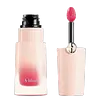What's inside
What's inside
 Key Ingredients
Key Ingredients

 Benefits
Benefits

 Concerns
Concerns

 Ingredients Side-by-side
Ingredients Side-by-side

Water
Skin ConditioningIsododecane
EmollientDiphenyl Dimethicone
EmollientPropylene Glycol
HumectantTalc
AbrasiveCetyl PEG/PPG-10/1 Dimethicone
EmulsifyingMenthone Glycerin Acetal
RefreshingBehenyl Dimethicone
Skin ConditioningDisteardimonium Hectorite
StabilisingPhenoxyethanol
PreservativeDimethiconol
EmollientTrimethylsiloxysilicate
EmollientSodium Dehydroacetate
PreservativeHydrogen Dimethicone
Disodium EDTA
Caesalpinia Spinosa Gum
Skin ConditioningAluminum Hydroxide
EmollientMaltodextrin
AbsorbentTropolone
Skin ConditioningWine
Skin ConditioningCI 77891
Cosmetic ColorantCI 77491
Cosmetic ColorantCI 77499
Cosmetic ColorantCI 77492
Cosmetic ColorantWater, Isododecane, Diphenyl Dimethicone, Propylene Glycol, Talc, Cetyl PEG/PPG-10/1 Dimethicone, Menthone Glycerin Acetal, Behenyl Dimethicone, Disteardimonium Hectorite, Phenoxyethanol, Dimethiconol, Trimethylsiloxysilicate, Sodium Dehydroacetate, Hydrogen Dimethicone, Disodium EDTA, Caesalpinia Spinosa Gum, Aluminum Hydroxide, Maltodextrin, Tropolone, Wine, CI 77891, CI 77491, CI 77499, CI 77492
Water
Skin ConditioningCyclopentasiloxane
EmollientPhenyl Trimethicone
Skin ConditioningIsononyl Isononanoate
EmollientAlcohol
AntimicrobialPEG-10 Dimethicone
Skin ConditioningGlycerin
HumectantBis-PEG/PPG-14/14 Dimethicone
EmollientVinyl Dimethicone/Methicone Silsesquioxane Crosspolymer
Tocopheryl Acetate
AntioxidantPhenoxyethanol
PreservativeMagnesium Sulfate
Dimethicone
EmollientDisteardimonium Hectorite
StabilisingDisodium Stearoyl Glutamate
CleansingOctyldodecanol
EmollientAlumina
AbrasiveAluminum Hydroxide
EmollientCI 77891
Cosmetic ColorantCI 77491
Cosmetic ColorantCI 77499
Cosmetic ColorantCI 15850
Cosmetic ColorantCI 19140
Cosmetic ColorantCI 15985
Cosmetic ColorantCI 42090
Cosmetic ColorantWater, Cyclopentasiloxane, Phenyl Trimethicone, Isononyl Isononanoate, Alcohol, PEG-10 Dimethicone, Glycerin, Bis-PEG/PPG-14/14 Dimethicone, Vinyl Dimethicone/Methicone Silsesquioxane Crosspolymer, Tocopheryl Acetate, Phenoxyethanol, Magnesium Sulfate, Dimethicone, Disteardimonium Hectorite, Disodium Stearoyl Glutamate, Octyldodecanol, Alumina, Aluminum Hydroxide, CI 77891, CI 77491, CI 77499, CI 15850, CI 19140, CI 15985, CI 42090
Ingredients Explained
These ingredients are found in both products.
Ingredients higher up in an ingredient list are typically present in a larger amount.
Aluminum Hydroxide is a form of aluminum. It can be naturally found in nature as the mineral gibbsite. In cosmetics, Aluminum Hydroxide is used as a colorant, pH adjuster, and absorbent.
As a colorant, Aluminum Hydroxide may add opacity, or reduce the transparency. Aluminum hydroxide is contains both basic and acidic properties.
According to manufacturers, this ingredient is an emollient and humectant. This means it helps hydrate the skin.
In medicine, this ingredient is used to help relieve heartburn and help heal ulcers.
There is currently no credible scientific evidence linking aluminum hydroxide in cosmetics to increased cancer risk.
Major health organizations allow the use of aluminum hydroxide in personal care products and have not flagged it as a carcinogenic risk at typical usage levels.
Learn more about Aluminum HydroxideCi 77491 is also hydrated iron III oxide. It's sole purpose is to give a red/pink hue to products.
Iron III oxides are classified as inorganic chemicals for coloring.
Synthetically created Ci 77491 is considered safer than those naturally found. This is because the synthetically created version may contain less impurities. Iron oxides are generally non-toxic and non-allergenic.
Learn more about CI 77491Ci 77499 is also hydrated iron III oxide. It is created from mixing red and black iron oxides. This helps give shades of darkness to a product.
Iron III oxides are classified as inorganic chemicals for coloring.
Ci 77891 is a white pigment from Titanium dioxide. It is naturally found in minerals such as rutile and ilmenite.
It's main function is to add a white color to cosmetics. It can also be mixed with other colors to create different shades.
Ci 77891 is commonly found in sunscreens due to its ability to block UV rays.
Learn more about CI 77891Disteardimonium Hectorite comes from the clay mineral named hectorite. It is used to add thickness to a product.
It can also help stabilize a product by helping to disperse other ingredients.
Hectorite is a rare, white clay mineral.
Learn more about Disteardimonium HectoritePhenoxyethanol is a preservative that has germicide, antimicrobial, and aromatic properties. Studies show that phenoxyethanol can prevent microbial growth. By itself, it has a scent that is similar to that of a rose.
It's often used in formulations along with Caprylyl Glycol to preserve the shelf life of products.
Water. It's the most common cosmetic ingredient of all. You'll usually see it at the top of ingredient lists, meaning that it makes up the largest part of the product.
So why is it so popular? Water most often acts as a solvent - this means that it helps dissolve other ingredients into the formulation.
You'll also recognize water as that liquid we all need to stay alive. If you see this, drink a glass of water. Stay hydrated!
Learn more about Water